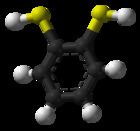Formula C6H6S2 Density 1.24 g/cm³ | Molar mass 142.24 g/mol Appearance colourless liquid | |
 | ||
1,2-Benzenedithiol is the organosulfur compound with the formula C6H4(SH)2. This colourless viscous liquid consists of a benzene ring with a pair of adjacent thiol groups. The conjugate base of this diprotic compound serves as chelating agent in coordination chemistry and a building block for the synthesis of other organosulfur compounds.
Contents
Synthesis
The compound is prepared by ortho-lithiation of benzenethiol using butyl lithium (BuLi) followed by sulfidation:
C6H5SH + 2 BuLi → C6H4SLi-2-Li + 2 BuH C6H4SLi-2-Li + S → C6H4(SLi)2 C6H4(SLi)2 + 2 HCl → C6H4(SH)2 + 2 LiClThe compound was first prepared from 2-aminobenzenethiol via diazotization. Alternatively, it forms from 1,2-dibromobenzene.
Reactions
Oxidation mainly affords the polymeric disulfide. Reaction with metal dihalides and metal oxides gives the dithiolate complexes of the formula LnM(S2C6H4) where LnM represents a variety of metal centers, e.g. (C5H5)2Ti. Ketones and aldehydes condense to give the heterocycles called dithianes:
C6H4(SH)2 + RR’CO → C6H4(S)2CRR’ + H2ORelated compounds
3,4-Toluenedithiol, also called dimercaptotoluene (CAS#496-74-2), behaves similarly to 1,2-benzenedithiol but is a solid at ambient temperatures (m.p. 135-137 °C).
Alkene-1,2-dithiols are unstable, although metal complexes of alkene-1,2-dithiolates, called dithiolene complexes, are well known.
